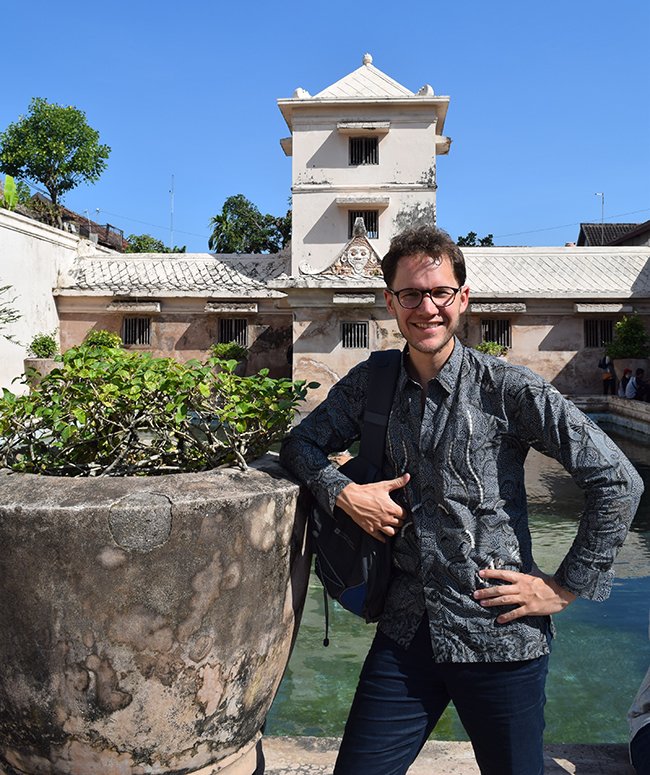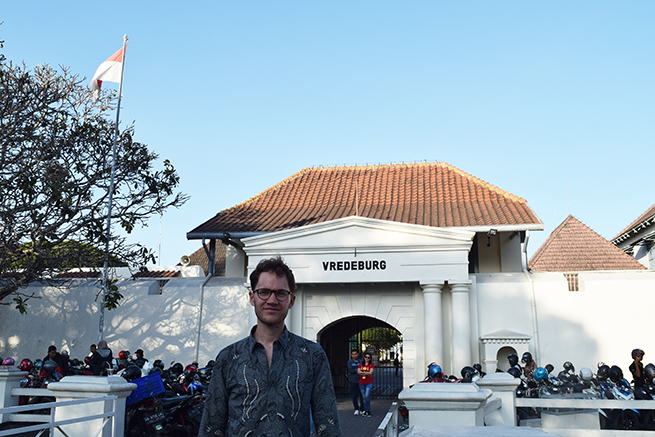
Report: In search of family roots in Java, July 2018
In the summer of 2018 Physics graduate student Yuri van Nieuwkerk (2016) went on a transformative journey along his family's roots, which was made possible by a Gerry Grimstone Travel Award.
The last time a member of my family walked the soil of Java was in January 1946, when Wanda van Essel, my grandmother, rushed to the port of Jakarta, then Batavia, to catch an ocean liner for The Netherlands. In the decade after the war, hundreds of thousands of Dutch citizens would follow a similar path, prompted by the end of Dutch colonial rule over Indonesia, a country about 50 times as big as The Netherlands. It was a dramatic time, in which the traumas of the Second World War were increased by a bloody colonial war and violent civil unrest. My grandmother never did return to Indonesia, her country of birth, and she died in The Netherlands 60 years later without ever seeing Java again.
It therefore was an emotional moment for me when I walked out of Sukarno International Airport on 5 July 2018, and took a taxi to Bogor, the town where my grandmother was born. It formed the beginning of a transformative journey along my family's roots, which was enabled by Merton's Gerry Grimstone Travel Award. On this trip, I would discover a land that is on the one hand alien and exotic to me, but at the same time steeped in smells, tastes and cultural practices that I know from home.
The curious mixture of familiarity and exoticism immediately surrounded me as I reached Bogor. My sister, who had arrived before me, took me to the birth place of my grandmother on the old Parallelweg, now Jalan Ardio. From a distance, we could already make out the shapes of a number of beautiful but extremely dilapidated Dutch villas. They were surrounded by a chaotic tangle of food stalls, rickshaws and mopeds, which made for an extremely confusing sight: a combination of a familiar, even somewhat boring Dutch residential area with a quintessentially south-east Asian street scene, filled with unfamiliar noises, languages and smells. The confusion further increased when we decided to stop by a gorengan stall, one of the local deep-fried food carts which travel guides had warned us against. Overcoming our slight fear of stomach issues, we found they served the exact same pisang goreng, or fried banana, which my grandmother used to make!

Another particularly beautiful piece of family history was offered by the train ride from Bogor to Bandung. Winding through tropical forests, volcanic mountain ranges and typical rice terraces, the original track was actually laid out by the very same Dutch institution for which my great-grandfather Kees van Essel worked as a railway engineer. Though impossible to tell now, some of the many elegant steel bridges we crossed on our way to Bandung might well have been designed by his very team.

In Bandung, we found the same blend of highly dilapidated Dutch colonial buildings with the bustling life of modern-day Indonesia. It was interesting to see how little room is given to Dutch colonial history in the preservation of monumental buildings: many important Dutch sites are now in a rather ramshackle state, and a form of active preservation through museums or information boards is hardly ever present. It quickly became clear to us that Indonesia has rapidly moved forward after the war, and that Dutch colonial history is not a thing many young Indonesians seem too concerned with.
For us, however, there were plenty of aspects to modern Indonesian society which brought our family history to life. One of these could be found in Yogyakarta: it was there that my great-great-grandmother lived for the early part of her life, as a raden ayu, or lady-in-waiting, at the court of Yogyakarta's sultan. Amazingly, this court still exists, preserving its ancient traditions in a careful way. To many Yogyakartans, the sultan is as much a spiritual leader today as he was a hundred years ago. For us, the sultan's palace turned out a treasure trove of living Javan traditions, which conjured up the atmosphere of family gatherings at my grandmother's place. The ceremonial textiles, or batik, the way the table is made, the social etiquette: our visit to the palace showed us that many habits we thought were just peculiar oddities of our grandmother's were in fact deeply ingrained cultural traits, inherited from a rich and ancient court culture. Of particular note here was a wayang kulit, or puppet performance, with traditional gamelan music. Our father, who is a composer, has been inspired by this style in much of his life and work. Hearing the music so close to its source was a fantastic experience.

As we discovered more and more elements of Javan culture that had subconsciously played a role in our family and upbringing, we noticed a host of words in bahasa Indonesia which we actually use in our own family. For example, we noticed how Indonesians, too, refer to:
- senang when they feel happy;
- pinter when they say somebody is clever; or
- pidjit for giving someone a massage.
Encouraged by these familiar words, we started practising bahasa Indonesia, and soon found out that it isn't that hard to learn. And suddenly, the mysteriously exotic language we had often heard our grandmother speak with her siblings became a living language to us, that we could use ourselves.
This exemplified the transformative nature of our trip: in travelling through Java, not only did we get to know a fascinating modern country, we also got to know our own family in a new way, and it brought aspects of our own identity to life which we thought we might have lost. It is this priceless experience of understanding one's origins for which I am deeply indebted to Merton and its Gerry Grimstone Travel Award.